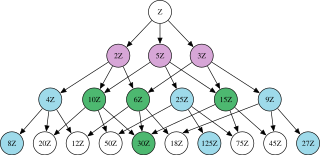In mathematics, more specifically in ring theory, a Euclidean domain is an integral domain that can be endowed with a Euclidean function which allows a suitable generalization of the Euclidean division of the integers. This generalized Euclidean algorithm can be put to many of the same uses as Euclid's original algorithm in the ring of integers: in any Euclidean domain, one can apply the Euclidean algorithm to compute the greatest common divisor of any two elements. In particular, the greatest common divisor of any two elements exists and can be written as a linear combination of them. Also every ideal in a Euclidean domain is principal, which implies a suitable generalization of the fundamental theorem of arithmetic: every Euclidean domain is a unique factorization domain.

In algebra, a prime ideal is a subset of a ring that shares many important properties of a prime number in the ring of integers. The prime ideals for the integers are the sets that contain all the multiples of a given prime number, together with the zero ideal.
In abstract algebra, a principal ideal domain, or PID, is an integral domain in which every ideal is principal, i.e., can be generated by a single element. More generally, a principal ideal ring is a nonzero commutative ring whose ideals are principal, although some authors refer to PIDs as principal rings. The distinction is that a principal ideal ring may have zero divisors whereas a principal ideal domain cannot.

In mathematics, a ring is one of the fundamental algebraic structures used in abstract algebra. It consists of a set equipped with two binary operations that generalize the arithmetic operations of addition and multiplication. Through this generalization, theorems from arithmetic are extended to non-numerical objects such as polynomials, series, matrices and functions.
In mathematics, more specifically in the area of abstract algebra known as ring theory, a Noetherian ring is a ring that satisfies the ascending chain condition on left and right ideals, which means there is no infinite ascending sequence of left ideals; that is, given any chain of left ideals,
In mathematics, a unique factorization domain (UFD) is an integral domain in which every non-zero non-unit element can be written as a product of prime elements, uniquely up to order and units, analogous to the fundamental theorem of arithmetic for the integers. UFDs are sometimes called factorial rings, following the terminology of Bourbaki.
In ring theory, a branch of abstract algebra, a commutative ring is a ring in which the multiplication operation is commutative. The study of commutative rings is called commutative algebra. Complementarily, noncommutative algebra is the study of noncommutative rings where multiplication is not required to be commutative.
In the mathematical field of ring theory, a principal ideal is an ideal in a ring that is generated by a single element of through multiplication by every element of . The term also has another, similar meaning in order theory, where it refers to an (order) ideal in a poset generated by a single element , which is to say the set of all elements less than or equal to in .
Ring theory is the branch of mathematics in which rings are studied: that is, structures supporting both an addition and a multiplication operation. This is a glossary of some terms of the subject.
In algebra, Gauss's lemma, named after Carl Friedrich Gauss, is a statement about polynomials over the integers, or, more generally, over a unique factorization domain. Gauss's lemma underlies all the theory of factorization and greatest common divisors of such polynomials.
In mathematics, a principal right (left) ideal ring is a ring R in which every right (left) ideal is of the form xR (Rx) for some element x of R. When this is satisfied for both left and right ideals, such as the case when R is a commutative ring, R can be called a principal ideal ring, or simply principal ring.
In commutative algebra, a Krull ring or Krull domain is a commutative ring with a well behaved theory of prime factorization. They were introduced by Wolfgang Krull (1931). They are a higher-dimensional generalization of Dedekind domains, which are exactly the Krull domains of dimension at most 1.
In commutative algebra, an integrally closed domainA is an integral domain whose integral closure in its field of fractions is A itself. Many well-studied domains are integrally closed: Fields, the ring of integers Z, unique factorization domains and regular local rings are all integrally closed.
In abstract algebra, the ascending chain condition can be applied to the posets of principal left, principal right, or principal two-sided ideals of a ring, partially ordered by inclusion. The ascending chain condition on principal ideals is satisfied if there is no infinite strictly ascending chain of principal ideals of the given type (left/right/two-sided) in the ring, or said another way, every ascending chain is eventually constant.
This is a glossary of commutative algebra.


